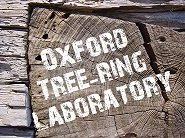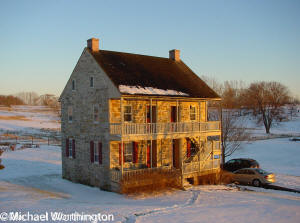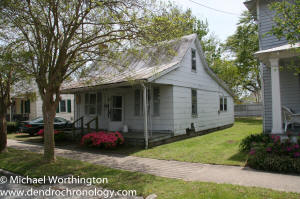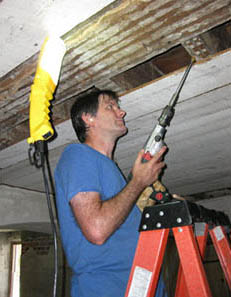Sampling Procedures

Sampling Procedures
The aim of sampling a phase of building, or an archaeological feature, is to take sufficient samples to ensure that the timbers are representative of the structure being studied, i.e. to be confident that the timbers selected have not been reused from an older building at the time of sampling, or are later repairs, or both. Generally, between 6 and 10 well-provenanced samples are taken from a single phase to ensure that they are primary first-use timbers. This number of samples also gives a good chance for any individual growth irregularities in the tree to be averaged out.
Of course, sampling is often reduced by the lack of suitable ring sequences within the timbers available. Obviously, the primary strategy in selecting samples within a structure is to choose those with ring sequences that are likely to date. When these are of marginal quality, i.e. less than 75 rings, more than the average number should be taken, if they are available, to increase the likelihood of the site dating. Another factor determining sample number is the presence of sapwood. To better understand the probable construction date of any phase of building, as many samples as possible with complete sapwood need to be taken. However, in any typical timber-framed building only one or two, and rarely more than five or six, samples with complete sapwood would survive the initial conversion of the timbers and subsequent degradation and attrition over the ensuing centuries. Therefore, a priority in sampling is always to try to obtain as many samples as possible with bark edge and high ring counts.
Sampling methods
The most economical method of sampling is to have sections of timber offcuts supplied by the client. However, these are rarely the most useful, in that they rarely retain complete sapwood or are of the most sound condition. The very reason that they had been cut out of a standing building suggests that they were already fairly well decayed, and the first casualty of decay is the outermost sapwood rings.
The most practical method of obtaining the best samples with the least intervention with a standing historic building is through in situ sampling. This is achieved through drilling a 16mm hollow corer which produces a core approximately 10mm in diameter. These core bits are specially manufactured for the purpose and have hardened steel teeth capable of cutting through steel, which is necessary to cut through timber hardened by centuries of seasoning. This is effected through the use of a 100w 110v drill with gear reduction and variable speeds so as to have sufficient torque and power to drill at the slow speeds required. The drill is run at sufficiently slow speeds so as to not be considered ‘hot work’. The 110v power supply should be protected by an earth leakage trip switch tested before use. Extension leads should be lifted off the floor where traffic might be expected, or protected where this is not practicable. Sampling should not be carried in areas which are being intensively worked in by other contractors as full concentration must be given to the process of drilling the core smoothly. Lighting is important and is best from a small spot light. Where samples have been taken from visible timbers in the habitable areas of buildings, the resulting hole is plugged with a ramin dowel, stained and distressed to match the surrounding surface.
The best cores should have a sequence of tree-rings of at least 50, and ideally 100 years. Ideally, too, they should retain the final ring at the bark edge: that is, the last ring that was grown in the year in which the tree was felled. Therefore, the best samples are from large, slow-grown timbers, without distortions, and with bark edge remaining. The timber must be dry - oak timbers which have been exposed to rain will not core successfully. When timbers have been allowed to become soaked through exposure to weather, it can sometimes take a year for the oak to dry out. Roof spaces with no ventilation can also have high moisture build-up in the timbers.
Once the samples are obtained, and are thoroughly dry, they are then sanded on a bench-mounted belt sander, or linisher, using 60 to 1200 grit abrasive paper, and were cleaned with compressed air to allow the ring boundaries to be clearly distinguished.
Other sampling techniques might involve photography, impressions, and direct in situ measurements with a graticule, but these are not often used for a variety of practical reasons.
Recording sample positions
It is vital to accurately record which timbers have been sampled. This is best done by the building recorder if there is one, and if not, a set of plans is a must. It is also necessary to determine the map location for the site.
Health and Safety Considerations
Given that it can take up to 20 minutes to take a core sample from a timber, a safe working platform is necessary. Working from tall ladders can be dangerous and is not often suitable. Any high level work above 2 metres generally require a mobile scaffold tower which need to conform to the relevant Health and Safety regulations. A dust mask should be worn in situations in which dust might be inhaled, and safety goggles worn when working overhead.
Work in isolated situations, or from scaffolds or ladders, or with other risk factors must never be undertaken alone. It is usually best for the client or his/her representative to accompany the dendrochronologist to site. Roof spaces can be equally dangerous where there are no boards to walk on, and it is necessary to have some short boards on hand to use in any roof spaces.
Oxford
Tree-Ring
Laboratory
The Oxford Tree-Ring Laboratory provides cutting-edge commercial dendrochronological services to homeowners, architectural historians, and cultural resource managers. READ MORE
Contact Information
Oxford Tree-Ring Laboratory
ProprietorsMichael Worthington
Jane Seiter, Ph.D
25 E. Montgomery St.
Baltimore, MD 21230
410-929-1520
Basic Dendrochronology

The Laboratory's staff have been involved in scientific dating of over two hundred historic building both in the USA and UK. Detailed listing of all of them can be found READ MORE
Sampling Procedures

After two years of investigation of what was a planned rental property,
the oldest dated house in North Carolina has been identified in Edenton.
Preservationists with the N.C. Historic Preservation Office, architectural
historians with the Architectural Research Department at Colonial
Williamsburg and local historians participated in the research. READ MORE
Book Shop

Must Have Book!
For more than
thirty years, the architectural research department at Colonial Williamsburg
has engaged in comprehensive study of early buildings, landscapes, and
social history in the Chesapeake region. READ MORE
